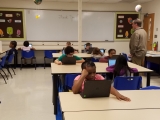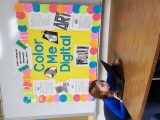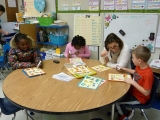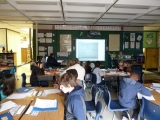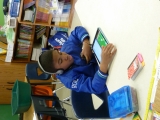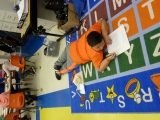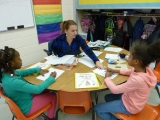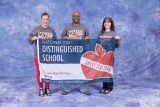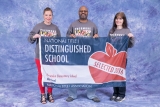-
Category 1
Selected in 2016
-
Grades: pre k - 3
School Setting: rural
Town Population: 4,186
Student Enrollment: 383
Student Demographics:
Black/African American: 47%
Teacher/Student Ratio: 1:16
White/Caucasian: 40%
Hispanic: 6%
Hawaiian/Pacific Islander: 0%
Asian: 3%
Native American: 0%
Other: 4%
% Reduced Lunch: 71%
% ELL Learners: 4%
Founded: 1976 -
PRINCIPAL:
Michael Browne -
CONTACT:
2119 Pocomoke Beltway
Pocomoke, MD 21851
410-632-5130
MAFreistat@mail.worcesster.k12.md.us
Pocomoke Elementary
Pocomoke, MD
Our school culture reflects words of Henry David Thoreau: “Things do not change; we change.”
- Describe specific programs in place to ensure that families are involved in the success of your school and students.
- Digital Learning Projects provide opportunity for students/parents to explore the internet together. Families search theme-based websites, with adult supervision, to discover educational internet opportunities beyond gaming and social media. Projects include: The Great Digital Escape, Dive into Digital Discoveries, and Color Me Digital. Virtual field trips, live web cams, and museum tours spark childhood curiosity! Students are encouraged to use imagination and creativity to create 3D artifacts depicting internet journeys. American Education Week invites parents to join children in classroom activities! Parent Nights, Career Day, National School Lunch Week, Dancing through the Decades, Family Reading Day, Raising a Reader and Field Day events offer opportunities for parents to share in special moments with their children. Parents support our Kiwanis Kids’ activities funding local charities and our Literacy Project with generous contributions establishing in-home student libraries!
- Describe the most successful activity your school has initiated to strengthen ties to your community.
- A phenomenally successful faculty-sponsored initiative embraces students’ artistic and musical talents to touch lives of the less fortunate. School-community collaboration is achieved through combined effort of parents, teachers, businesses and agency personnel. Our student choir performs locally with special consideration given to audiences of the disadvantaged, disabled and elderly. Holiday performances include: Lions Club, nursing homes, adult day care center and the Mayor’s Old Fashion Christmas. Our choir launches both our Little League season and Spring Festival. Our Kiwanis-Kids Club conducts a Food Drive for the Maryland Food Bank, a Pet Food Drive for the county animal shelter, a Pajama Drive for families in need and fundraises for the Samaritan Shelter. Students create holiday cards for the elderly and U.S. service men and women stationed abroad. Focusing upon community needs, students take personal ownership of their future by creating one trusting relationship at a time!
- Describe your philosophy of school change or improvement.
- Our philosophy of school change is captured in words of George Bernard Shaw: "The only man who behaves sensibly is my tailor; he takes my measurements anew every time he sees me, while all the rest go on with their old measurements and expect me to fit them.” School change must be evidence based, timely and in best interest of students. For students to be globally competitive in College and Career Readiness, the initial school experience must be a positive one! As students transition through grades, and individual family circumstances change, it is imperative that we continue progress monitoring of the “whole” child. Students must be provided equitable access to science, technology, engineering, art, math (STEAM) and literacy opportunities to escape economic hardships of past generations. Our school change inspires “childhood” curiosity and imagination through blended learning and an arts-enhanced curriculum that builds excitement, discovery and a lifelong passion for learning!
- What are your school’s top two goals for the next year?
- Goal #1 is to increase effective use of blended learning across content and grade levels resulting in a significantly positive impact on student achievement. To be confident in learning, working and completing day-to-day functions, it is imperative that our students become proficient in accessing and processing online information available in our 21st Century Global Society. Goal # 2 is to increase partnership with churches, businesses and community agencies to extend our “school” into the community. For families living in homes of poverty, transportation remains a tremendous obstacle in visiting our school campus. Some families experience substance abuse, illiteracy, crime and chronic illness often associated with poverty. The school campus may not be comfortable for parents lacking confidence in their own abilities. Meeting parents off campus in the local library or fire hall may reduce tension and assist in building stronger, trusting relationships between school and home.
- What is the single most important factor in the success of your school that others could replicate?
- Collaboration between school stakeholders is a success factor! Teachers embrace opportunities to build trusting parent relationships and encourage their participation in student learning. Teachers begin each year with an initial positive contact welcoming the family into our school community. Children leave school daily with a “My Day” form providing parents with the day’s “snapshot.” Positive referrals are forwarded to parents when students make decisions with positive outcomes. Parents are encouraged to volunteer, chaperone, visit classrooms and participate in our School Improvement Advisory Committee Meetings. Parent Nights in Literacy, Math and Technology introduce content proficiencies and strategies for assisting children. Parent surveys provide feedback on school events. Student programs, such as Junior Achievement which supports financial literacy, are funded through community partnerships such as McDonalds, Walmart, Vulcan, Lowe’s, Dollar General and the Wahl Foundation.
- Describe the program or initiative that has had the greatest positive effect on student achievement, including closing achievement or opportunity gaps, if applicable.
- Our Formative Assessment for MD Educators (FAME) Initiative has yielded significant impact upon student achievement and confidence. Sharing learning goals and success criteria enables all students to know where they are headed in their learning. Non-evaluative learning checks embedded within instruction inform students where they are in their learning. Feedback offered in amounts perceived as “do-able” and planned next steps support students in closing the gap between the two. There are no “wrong” answers but opportunities to grow and select more efficient problem-solving strategies. Students learn to peer assess, offer feedback and build capacity to self-assess. Students assume ownership for learning, build self-esteem and an expectation for success! FAME is now extended to faculty through the MD Collaborative Model for Peer Coaching which supports professional development using data collection, peer/self-assessment and descriptive feedback strategies within a learning partnership.
- Explain how Title I funds are used to support your improvement efforts.
- Title I funds provide teaching/paraprofessional positions reducing class size and increasing adult/student ratios. As 71% of our students qualify for FARMS, poverty plays a significant role in childhood experiences. Families struggling to meet basic survival needs have little money to support early learning. Title I funds assist with supplemental resources, materials and equitable access to educational tools, technology and school programs. Title I funds support an assessment coach who facilitates our Formative Assessment for MD Educators and Peer Coaching professional development courses, as well as, our Response to Intervention process. Our online reading/math intervention and diagnostic program is Title I funded. Title I sponsors parent-student training nights in math, reading, writing, technology and our Social Emotional Foundations for Early Learning Programs. These trainings are facilitated by Title I funded literacy and math coaches and our school-based Title I Coordinator.
- Identify the critical professional development activities you use to improve teaching and student learning.
- As a Formative Assessment for MD Educators School, two teacher cohorts have now completed a course sponsored by the MD State Department of Education. Facilitated by our assessment coach, training includes webinars, application activities and Community of Practice Meetings. This process aligns with our 5 D+ Teacher Evaluation, Response to Intervention and Teaching/Assessing Cycle processes. Formative assessment is embedded within instruction and followed with feedback adjusting teaching/learning. Student learning is guided through learning goals/success criteria, learning progressions, feedback, peer/self-assessment and teacher/student partnership. We also implement the MD Collaborative Model for Peer Coaching Initiative utilizing strengths within our faculty (Field Experts) to support teacher capacity to meet student needs. Our motto: “We are Better Today than We Were Yesterday” represents our desire as a Community of Learners to continually grow in providing a World Class Education!
- Describe how data is used to improve student achievement and inform decision making.
- Summative/formative assessment data drives instructional decision-making. As a Formative Assessment for Maryland Educators School, “in-the-moment” formative assessments “for” student learning are instructionally embedded. Summative assessments “of” learning occur at instruction’s completion. Our formative assessment process includes observation, pre-assessment, discussion, product and questioning, followed with descriptive feedback/determination of next steps. Common formative assessments are collaboratively created, administered and reviewed during our “Teaching/Assessing Cycle.” Data results in multi-tiered levels of instruction that meet intervention and enrichment needs. Our online reading and math intervention/enrichment program individualizes student lessons with a summative diagnostic administered three times yearly. Progress monitoring determines differentiated instruction and flexible grouping strategies and School Leadership Team decisions proactively address student needs.
- Describe your school culture and explain changes you’ve taken to improve it.
- Our school culture reflects words of Henry David Thoreau: “Things do not change; we change.” Through state-sponsored training in Maryland Model for Collaborative Peer Coaching, we restructured school culture to embrace the “unity” in community. Grade-level faculty members, previously referred to as instructional “teams,” are now identified as “communities.” The competitive nature associated with a team was replaced with caring support which characterize a community. Teachers advance in professional capacity through collaborative peer coaching, a sharing of proven talents and competencies among colleagues. Faculty members partner as needed in trusting relationships with peers (Field Experts) who visit classrooms, collect data and provide feedback. Students gain instructional expertise of an entire faculty supporting each other as a “Community of Learners.” We find that we learn best from each other and continually acknowledge in our motto: “We are Better Today than Yesterday!”
Stats
-
Category 1
Selected in 2016
-
Grades: pre k - 3
School Setting: rural
Town Population: 4,186
Student Enrollment: 383
Student Demographics:
Black/African American: 47%
Teacher/Student Ratio: 1:16
White/Caucasian: 40%
Hispanic: 6%
Hawaiian/Pacific Islander: 0%
Asian: 3%
Native American: 0%
Other: 4%
% Reduced Lunch: 71%
% ELL Learners: 4%
Founded: 1976 -
PRINCIPAL:
Michael Browne -
CONTACT:
2119 Pocomoke Beltway
Pocomoke, MD 21851
410-632-5130
MAFreistat@mail.worcesster.k12.md.us


